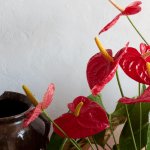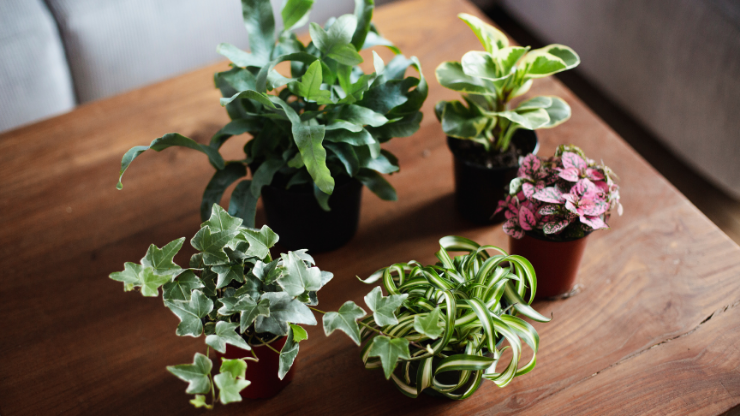
If your houseplants are growing more slowly than you’d like, follow these expert tips on how to make indoor plants grow faster. The most important thing you can do is increase bright light, but ensuring your plants have enough water and adequate humidity is also important.
I’m also sharing tips on how to increase foliage and/or flowers, depending on the type of plant. Plus, household items you can use to make your plants grow faster. There are a number of techniques you can try, so don’t let yourself get frustrated by slow growth.
How to Make Indoor Plants Grow Faster
The easiest way to make indoor plants grow faster is to increase the amount of bright light they receive. Regular feeding, re-potting when your plants outgrow their containers, pruning or pinching back, and providing enough moisture can also produce faster growth.
Let’s take a look at five easy things you can do right now to get your plants growing faster and keep them healthy for years to come.
1.) Increase Bright Light
Even low-light plants benefit from exposure to bright, indirect light. Plants that survive or tolerate lower light levels grow faster when placed in a brighter area. Just because low light is tolerated, does not mean it’s ideal for optimal growth.
If you’re serious about growing houseplants, learn the compass orientation of your home. There are numerous free compass apps you can download on your phone that tell you which way your windows face. This is very important!
When looking at your specific plant’s care guide, the ideal location for that plant is provided based on direction. This will help you choose the best place in your home. (This assumes you’re growing in natural light. We’ll cover artificial lights later in this post.)
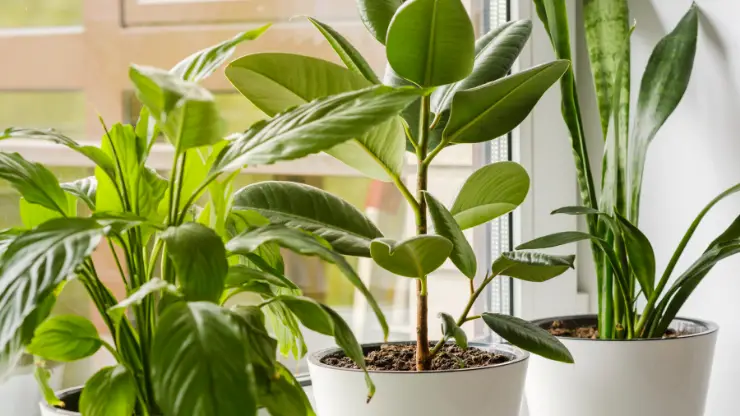
Most houseplants thrive in east- or west-facing windows. But the sunlight may be too strong for other types. If your plant is growing slowly, this is usually a sign that it isn’t receiving enough light. It’s important to provide BRIGHT INDIRECT light – not direct sun.
If you notice leaves turning brown from too much sunlight – especially hot afternoon sun – try filtering the light by hanging sheer curtains in your window. South-facing windows always produce the strongest light, and it’s usually too strong for most tropical houseplants.
I experienced an EXPLOSION of growth when I started growing my plants under artificial plant lights. My house is rather dark and I only have a few east-facing windows for natural light. I bought a couple of these inexpensive plant lights from Amazon and my plants TOOK OFF!
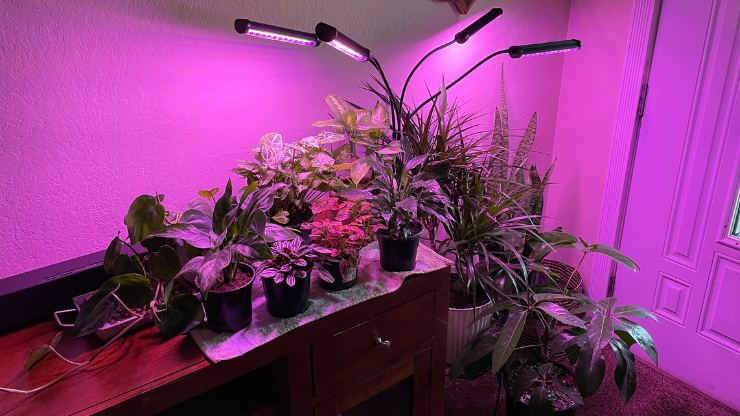
I love this light in particular because it has four adjustable heads, so I can cover the largest possible area with light. In the picture above, you can see how many plants I’m growing under a single light. It also has an automatic timer; set it once and it automatically turns on and off.
My dieffenbachia was dying in my east-facing front window, but as soon as I placed it under this light it started thriving. You can also see how fast my pothos is growing. It’s starting to vine right off the end of the table. My peace lily is producing more flowers too!
In my experience, artificial lights are the best way to make indoor plants grow faster. Full-spectrum LED light exposure for 8 – 10 hours a day will have your plants growing bigger, stronger, and healthier than you ever dreamed possible.
2.) Provide Enough Moisture
After increasing bright light, the next step is to make sure your plant gets enough water and humidity. In most cases, you’ll know your plant is moisture-deprived because it will begin to droop, leaves will turn yellow and fall off, or you’ll see brown leaf edges.

As with light, different plants need different amounts of moisture. So, always check your individual plant’s care requirements. Here are some general guidelines to follow:
- Keep soil moist. Never allow the potting medium to dry out completely. Very few plants can tolerate complete drought. And even if they can tolerate it, they certainly won’t thrive and grow quickly when they’re all dried out.
- Water more during active growth. When temperatures are warm and plants are actively growing in the spring and summer, they generally require more water. If you grow plants under artificial light, they may need the same amount of water year-round.
- Water more in dry air. If you live in a very dry area (like the desert where I live), your plants require more water than they would in a tropical, humid environment. If you use central heating in the winter, this also dries the air out significantly. In these situations, water more frequently and provide supplemental humidity for plants that require it.
- Increase humidity near plants. Mist your plants regularly with a spray bottle filled with room temperature water, place them on humidity trays, and/or place a good quality humidifier in the room near your plants. If you don’t have access to a humidifier, see my post on How to Increase Humidity for Plants Without a Humidifier.
All of these are general guidelines. As always, make sure to check the specific requirements for your individual plants. All houseplants are individuals and it can take some time to figure out exactly how much moisture they need.
But keeping them well-hydrated and improving humidity levels is one of the best things you can do to make indoor plants grow faster. Dried out plants will not grow well and may die completely if you let them go too long without a drink.
3.) Feed Plants Regularly
Another important way to make indoor plants grow faster is to feed them regularly. Although plants get much of their nutrition through light/photosynthesis, it’s still important to provide extra nutrients through the soil by applying fertilizer.

How often to feed your plants depends on the type, just like with light and water. However, there are some general guidelines you can follow.
- Start fertilizing houseplants in early spring before new growth begins. See my post on When to Start Fertilizing Houseplants in Spring for more information.
- Feed once a month with a houseplant fertilizer diluted to half strength. Use a good all-purpose food like Jack’s Houseplant Special once or twice a month, depending on the needs of the specific plant.
- Don’t feed plants in winter when they’re dormant. Winter-flowering plants or plants grown under artificial lights are an exception. See my post on Fertilizing Indoor Plants in Winter for more information.
4.) Allow Room to Grow
If your houseplants have outgrown their current containers, this can stop them from growing any larger. How do you know if you need to re-pot in a larger container? Look for these signs:
- Roots are growing out of the drainage holes in the bottom.
- Roots are pushing the plant up, out of the container, so that it appears to be popping out of the pot.
- Your plant is growing slower than normal (because it doesn’t have enough room), or growth stops completely in spring and summer.
- Your plant frequently falls over because it’s become top-heavy with foliage.
- Your plant is chronically thirsty even when you water it regularly.
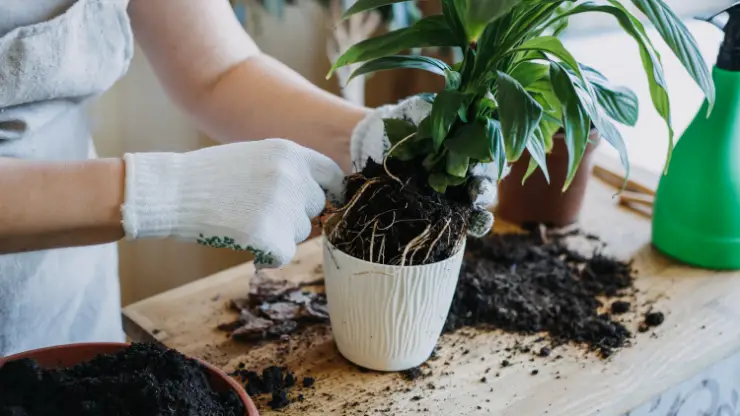
For most plants, re-pot in spring just before new growth begins. Choose a new container that’s 2 inches (5 cm) in diameter larger than the current one. Some large or fast-growing plants may need a container 4 inches (10 cm) larger, so always check your specific plant’s care guide.
5.) Prune to Encourage Growth
Pruning is another way to make indoor plants grow faster. Encourage your houseplants to grow more quickly and become bushier by regular pruning. Of course, this depends on the individual plant, but here are some general guidelines:
- Prune when plants are actively growing. Plants that have lost their shape or have unhealthy branches are good candidates for pruning.
- Don’t prune too aggressively. To keep a plant bushy and full, prune some branches back to the base of the plant and allow some branches to remain longer.
- Cut back stems just above a leaf node (the place where leaves are attached to the stem). For the best results, use pruning shears to cut stems about 3/4 inch (1.9 cm) above a leaf node or other branch junction.
- Snip off old blossoms from flowering houseplants as needed. This process is called “deadheading” and it encourages your plants to produce more blooms.

Light pruning helps plants grow into balanced shapes and promotes new growth of leaves, stems, and flowers. Pruning is a necessary part of houseplant care, although some plants need more attention in this department than others.
How to Make a Plant Grow More Leaves
Getting your foliage plants to grow more leaves is pretty easy. First, I recommend following all the proper care guidelines for the individual plant and documented in this post. Make sure you have enough bright light, adequate moisture, and fertilizer appropriately.
If you really want to take foliage growth to the next level, use artificial plant lights AND a high-nitrogen houseplant fertilizer. High-nitrogen fertilizers (where the first number is higher than the other two) are designed to promote rapid growth and lush green color in your plant’s leaves.
I recommend placing foliage plants under artificial lights for 8 – 10 hours a day (as I’ve discussed before). Then, feed them regularly using a high-nitrogen fertilizer to promote foliage growth. You’ll have tons of beautiful, lush leaves very soon!
How to Make Houseplants Produce More Flowers
I recommend two primary tools to make houseplants produce more flowers – artificial light and high-phosphorus fertilizer.
Sound familiar? That’s because increasing the growth of both foliage and flowers requires the same components. Bright light and the right food encourages faster growth, no matter what type of houseplant you’re growing.

My favorite fertilizer to increase flower production in houseplants is Jack’s Blossom Booster. It’s specifically formulated for flowering plants to help them bloom more often. It contains a high phosphorus percentage for better roots and blooms.
Place your plants under artificial lights for 8 – 10 hours a day, if possible. Then, feed regularly (about once a month during active growth) with a high-phosphorus fertilizer like Jack’s Blossom Booster. You’ll have a crazy amount of beautiful flowers in no time!


